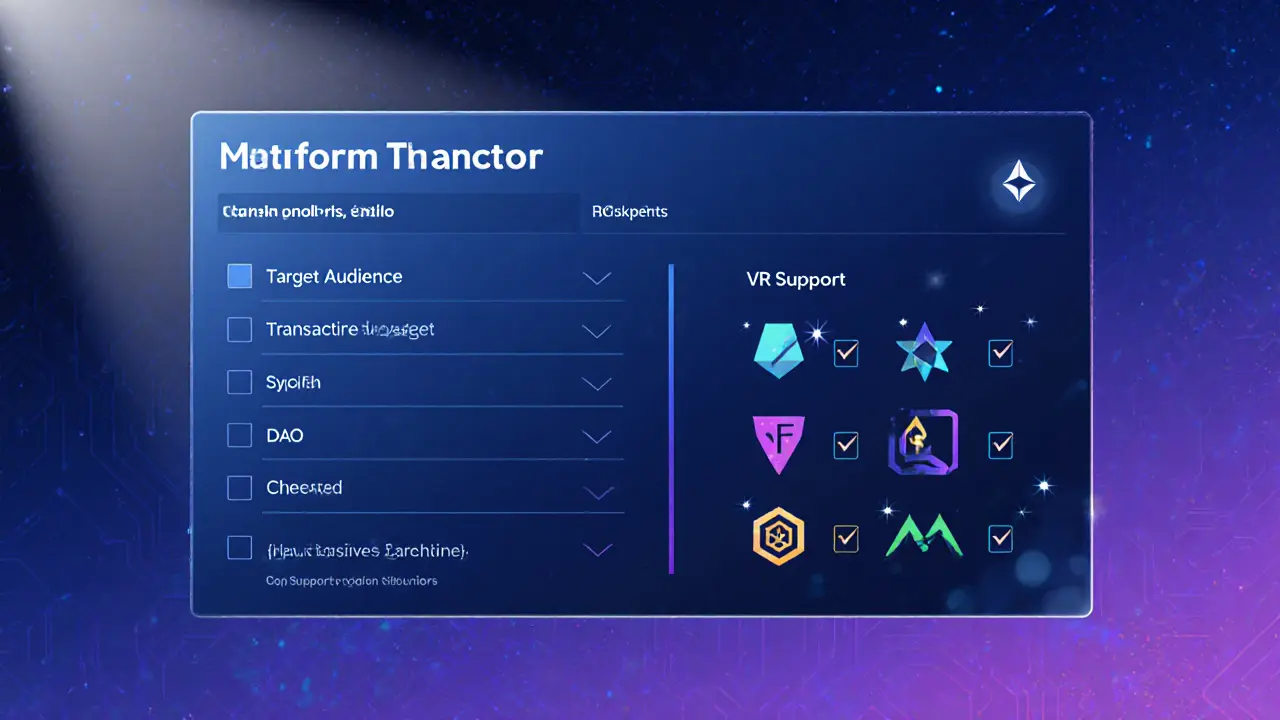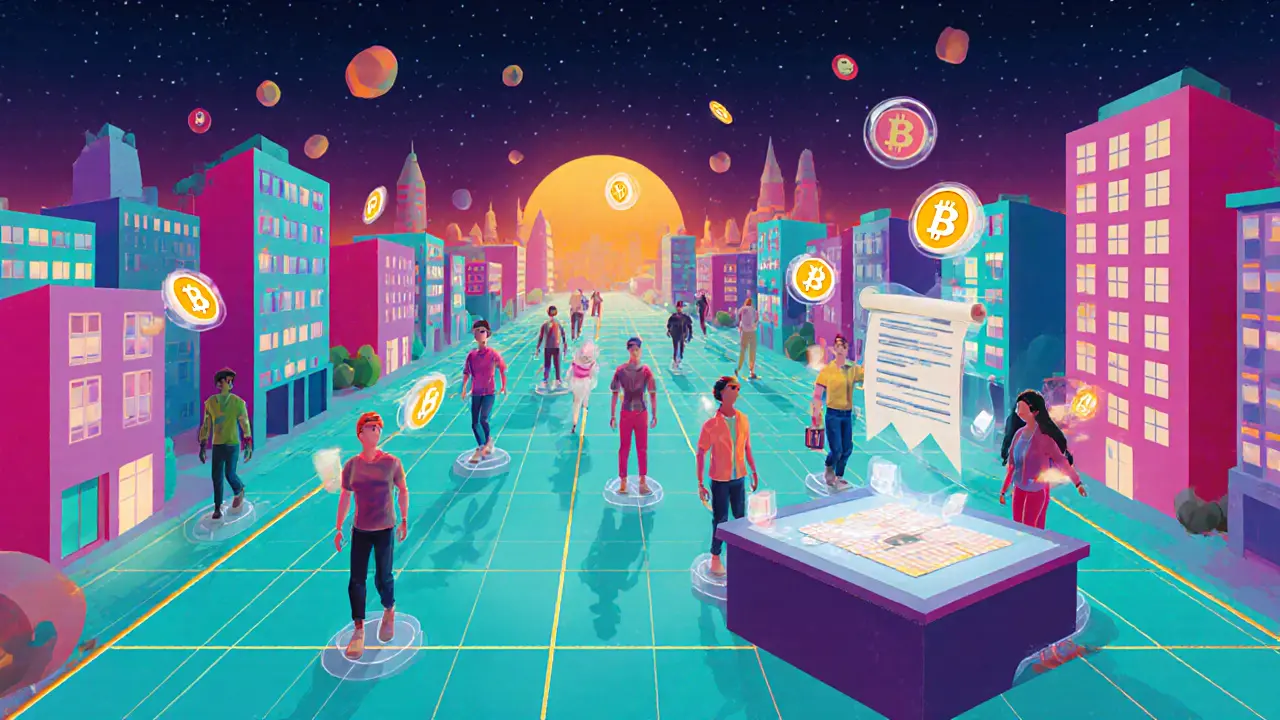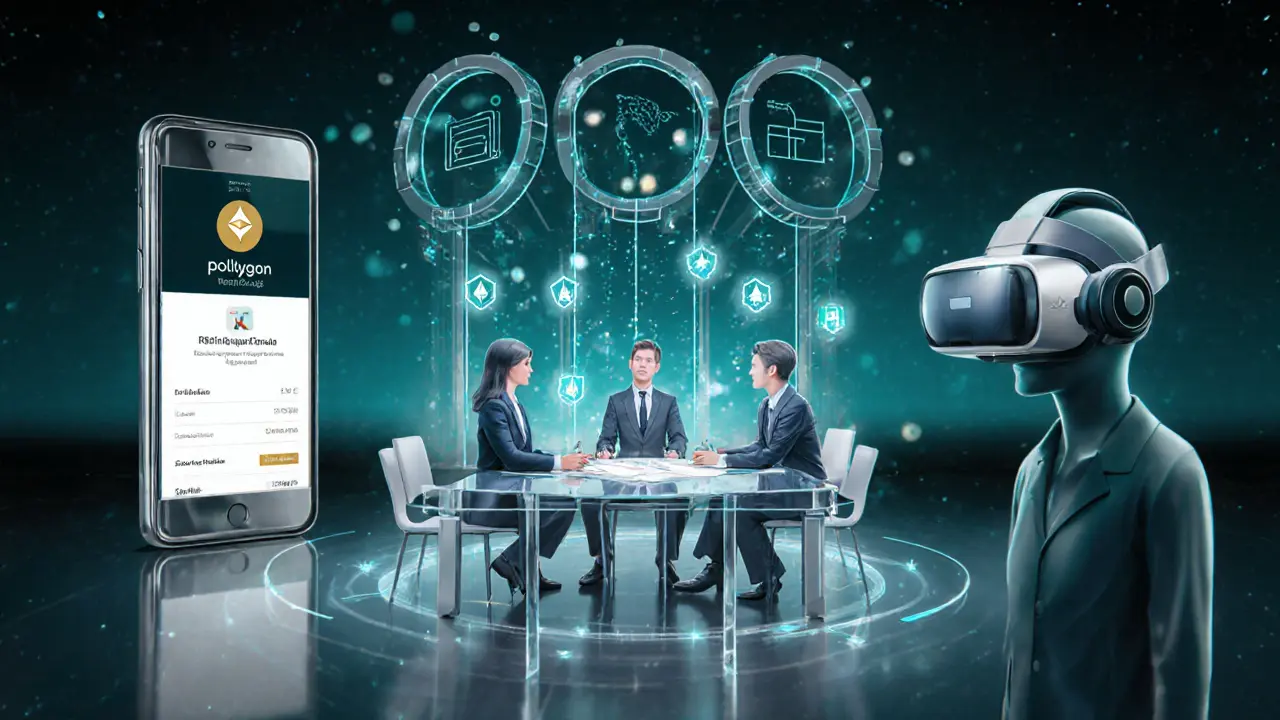Jan 1, 2025, Posted by: Ronan Caverly

Metaverse Platform Selector
Use this tool to compare key features of major blockchain metaverse platforms and find the best fit for your needs.
Recommended Platform
Key Features
Technical Details
Why This Platform?
Platform Comparison
Decentraland
MANABrowser-based, DAO governance
The Sandbox
SANDVoxel-style, no-code tools
Cryptovoxels
ETHLow-poly art, fast minting
Somnium Space
CUBEVR-first, full-body avatars
Key Takeaways
- Decentraland and The Sandbox dominate the 2025 market, each catering to different creator needs.
- Ethereum remains the go‑to base chain for openness, while Solana and Polygon offer cheaper, faster transactions.
- Choosing a platform hinges on token economics, developer tools, and the intended audience.
- Interoperability is becoming a decisive factor as bridges link separate virtual worlds.
- Future upgrades aim to blend DeFi, education, and commerce into richer metaverse economies.
When you hear blockchain metaverse platforms, you probably picture fancy avatars floating in a 3‑D space. What most people miss is the tech beneath the graphics: a decentralized ledger that guarantees true ownership of every pixel, plot of land, or in‑game sword. This article breaks down the biggest blockchain‑powered metaverses, the blockchains they run on, and the practical factors you should weigh before diving in.
What Makes a Metaverse "Blockchain‑Built"?
At its core, a blockchain‑based metaverse stores three things on‑chain: digital assets (NFTs), the token used for transactions, and the governance rules encoded in smart contracts. By anchoring virtual land, avatars, and wearables to NFTs, users can buy, sell, or lease them without a middleman. The native token-whether MANA on Decentraland or SAND on The Sandbox-acts as both currency and voting power, letting holders steer platform upgrades through a Decentralized Autonomous Organization (DAO).
Leading Platforms in 2025
Below is a quick snapshot of the most active worlds, followed by deeper dives.
| Platform | Base Blockchain | Native Token | Primary Focus | Notable Feature |
|---|---|---|---|---|
| Decentraland | Ethereum (Layer‑2 Polygon optional) | MANA | Open social world, events | Fully browser‑based, robust DAO |
| The Sandbox | Ethereum (Layer‑2 Polygon) | SAND | Voxel‑style gaming, brand IP | VoxEdit & Game Maker toolchain |
| Cryptovoxels | Ethereum | no native token (uses ETH) | Art galleries, low‑poly aesthetic | Fast land minting via simple UI |
| Somnium Space | Ethereum + custom sidechain | CUBE | VR‑first immersive experiences | Full‑body avatars & high‑res textures |
Deep Dive: Decentraland
Decentraland launched after a $24million ICO in 2017 and opened to the public in February2020. Built on Ethereum, it represents land as 10×10meter parcels called LAND NFTs. Owners can develop anything from virtual storefronts to concert venues. The MANA token fuels all in‑world purchases, and a DAO lets LAND and MANA holders vote on everything from fee structures to new content standards.
Key stats (Sept2025):
- ~12000 active LAND parcels, with prime locations fetching over 30ETH per plot.
- Average gas fee for a land purchase: $7USD (Ethereum mainnet) or $0.15USD on Polygon.
- Monthly active users: ~250000, driven largely by brand‑led events.
Because it runs in a web browser, Decentraland lowers the entry barrier-no heavy downloads or VR headsets required. That makes it a go‑to for corporate activations, art exhibitions, and community‑run DAO projects.

Deep Dive: The Sandbox
The Sandbox targets creators who want to build games without writing code. Its voxel art style feels like a cross between Minecraft and a digital arcade. The platform’s toolchain-VoxEdit for 3‑D modeling and Game Maker for logic-lets anyone turn a simple asset into a playable experience.
Notable partnerships in 2025 include Adidas, WarnerBros., and a seasonal campaign with the FIFA World Cup, each spawning limited‑edition NFTs that sold out in minutes.
Financial snapshot:
- SAND market cap: $1.2B (as of Oct2025).
- Average transaction fee on Polygon: $0.08USD.
- Top‑earning creator: a user who minted a “Space Racing” game that generated $750k in secondary sales.
Other Notable Worlds
Cryptovoxels offers a low‑poly canvas for digital art and pop‑up shops. Since it uses straight ETH for payments, newcomers familiar with MetaMask can jump straight in. Somnium Space pushes the envelope with full‑body avatars and native VR support, appealing to gamers who crave immersive realism.
All four platforms share a common thread: land is tokenized, assets are NFTs, and governance is on‑chain.
Underlying Blockchains: Speed, Cost, and Security
Choosing a metaverse often means picking a base chain. Here’s a quick primer on the most relevant networks.
- Ethereum provides the richest smart‑contract ecosystem and the deepest developer talent pool. Its downside is high gas, especially when the network spikes above $15 per transaction.
- Polygon (a Layer‑2 roll‑up) cuts fees to under $0.10 and speeds confirmation to <2seconds, making it ideal for micro‑transactions like avatar wearables.
- Solana processes >50kTPS with sub‑cent fees, which feels lag‑free for multiplayer games. However, its lower decentralization and past outages raise risk concerns.
- Polkadot offers parachain interoperability-assets can hop between Ethereum‑compatible and Solana‑compatible worlds without a centralized bridge.
- Flow (by Dapper Labs) shines for high‑volume NFT drops, thanks to a developer‑friendly SDK and near‑zero fees.
In practice, most platforms adopt a hybrid approach: core contracts on Ethereum for security, and sidechains or Layer‑2 solutions for day‑to‑day interactions.
How to Choose the Right Platform
Imagine you’re a brand looking to set up a virtual showroom. Your checklist might look like this:
- Audience reach. Browser‑based worlds (Decentraland) capture casual users; VR‑first worlds (Somnium) target hardware‑savvy gamers.
- Transaction costs. If you plan to sell cheap accessories, a Polygon‑enabled platform keeps fees invisible.
- Tooling. Do you need a no‑code builder? The Sandbox’s Game Maker wins.
- Governance model. A strong DAO (Decentraland) lets your community shape future updates.
- Interoperability. If you want assets to move between worlds, look for Polkadot‑compatible parachains.
By weighing these factors against your budget and timeline, you can avoid costly re‑migration later.
Future Trends Shaping 2026 and Beyond
Three big themes will dominate the next wave of blockchain metaverses:
- DeFi integration. Lending protocols now let you collateralize virtual land for crypto loans, blurring the line between real‑world finance and in‑game economies.
- Cross‑chain bridges. Projects like Wormhole v2 aim to let an NFT minted on Ethereum appear instantly on a Solana‑based world, unlocking true asset portability.
- Enterprise‑grade UX. Simplified login (email + wallet) and mobile‑first browsers are reducing the onboarding friction that once kept NFTs niche.
As these pieces click together, expect metaverses to expand from pure entertainment into education (virtual campuses), commerce (digital storefronts that ship physical goods), and professional collaboration (virtual offices with on‑chain payroll).

Frequently Asked Questions
What is the main advantage of using blockchain for a metaverse?
Blockchain provides provable ownership of digital assets, lets creators earn royalties automatically, and enables decentralized governance where users vote on platform upgrades.
Do I need a crypto wallet to enter Decentraland or The Sandbox?
Yes. Both worlds require a Web3 wallet (MetaMask, Coinbase Wallet, etc.) to sign transactions for buying land, NFTs, or in‑game items.
Which blockchain offers the lowest transaction fees for metaverse activity?
Solana and Polygon typically charge fractions of a cent per transaction, far cheaper than Ethereum’s on‑chain fees during peak periods.
Can I move an NFT from Decentraland to The Sandbox?
Direct transfer isn’t native yet, but bridge services like Wormhole or custom contracts on Polkadot parachains can wrap the NFT for cross‑world use.
Is there any real‑world value in virtual land?
Yes. Prime parcels have sold for six‑figure sums in ETH, and many owners lease space to brands, generating steady crypto income.
Write a comment
Comments
Marli Ramos
lol this metaverse thing is sooo overhyped 😂
January 1, 2025 AT 01:44
Christina Lombardi-Somaschini
Thank you for compiling such a comprehensive overview of the leading blockchain metaverse platforms; the inclusion of both technical specifications and user-focused considerations is commendable, and it provides a valuable reference for newcomers and seasoned developers alike. The juxtaposition of Decentraland’s DAO governance with The Sandbox’s voxel-centric creator tools illustrates the breadth of design philosophies at play. Moreover, the discussion of underlying blockchains-Ethereum’s security versus Polygon’s low fees-highlights the trade‑offs that must be weighed carefully. In sum, the article serves as an excellent primer for anyone seeking to navigate this rapidly evolving space.
January 9, 2025 AT 04:11
katie sears
I appreciate the balanced presentation of both user‑generated content ecosystems and the technical underpinnings; it underscores how governance models and tooling directly influence adoption rates. Notably, the emphasis on DAO mechanisms within Decentraland aligns with broader trends toward community‑driven development, while The Sandbox’s no‑code suite democratizes game creation across varying skill levels. This duality is essential for fostering inclusive growth in the metaverse arena.
January 17, 2025 AT 06:38
Gaurav Joshi
The moral of this story is clear: decentralization must not become an excuse for unchecked speculation; platforms should prioritize real value over hype.
January 25, 2025 AT 09:04
Kathryn Moore
Indeed, the emphasis on genuine utility over speculative bubbles is crucial; data shows that sustainable ecosystems retain users longer.
February 2, 2025 AT 11:31
Christine Wray
Great points all around; the article manages to stay neutral while still highlighting where each platform shines.
February 10, 2025 AT 13:58
roshan nair
Thanks for the balanced view-just a heads‑up, some of the fee numbers on Polygon can vary
depending on network congestion, so double‑check before committing large land purchases.
February 18, 2025 AT 16:24
Jay K
I would like to add that proper due diligence on smart‑contract audits is essential before investing in any of these platforms.
February 26, 2025 AT 18:51
Kimberly M
👍 Absolutely, safety first! Also, remember that many platforms now offer email‑wallet logins to simplify onboarding 😊
March 6, 2025 AT 21:18
Navneet kaur
People need to understand that without ethical governance these virtual worlds become playgrounds for the greedy, and that is unacceptable.
March 14, 2025 AT 23:44
Marketta Hawkins
Honestly, the US should focus on building its own metaverse infrastructure instead of copying European projects-patriotic development matters.
March 23, 2025 AT 02:11
Drizzy Drake
Choosing the right blockchain metaverse is really about matching your personal or business goals with the strengths each platform offers. If you’re a creator who wants a low‑code environment, The Sandbox’s Game Maker is unbeatable; it lets you upload assets, script simple interactions, and publish without writing a single line of Solidity. On the other hand, if community governance and decentralized decision‑making are your priorities, Decentraland’s DAO gives token holders a real voice in land pricing and feature rollouts. For those who care most about transaction costs, Polygon‑based versions of both Decentraland and The Sandbox slash gas fees to mere cents, which is ideal for frequent micro‑transactions like buying virtual wearables. Meanwhile, Somnium Space caters to the VR‑enthusiast crowd, offering full‑body avatars and high‑resolution textures that make the experience feel almost like a real world; however, you’ll need a VR headset and a higher budget because the CUBE token and sidechain fees can add up. If your focus is on art galleries or pop‑up shops, Cryptovoxels provides a low‑poly aesthetic that loads instantly, and its simple ETH‑only payment model reduces friction for casual buyers. Another angle to consider is interoperability-projects built on Polkadot or using bridges like Wormhole are beginning to let NFTs hop between worlds, so you’re not locked into a single ecosystem. Security is also paramount; platforms that keep their core contracts on Ethereum benefit from the network’s robust security model, while Layer‑2 solutions add speed without sacrificing safety when audited properly. Lastly, think about the long‑term roadmap: platforms that plan to integrate DeFi lending on virtual land or enable on‑chain royalties will likely sustain higher user engagement and value appreciation. In short, map out your requirements-whether it’s low fees, advanced tooling, VR immersion, or decentralized governance-and then align those with the platform that best satisfies each criterion.
March 31, 2025 AT 04:38
AJAY KUMAR
Wow, you really think a sandbox game can compete with a true national digital frontier? The drama is real!
April 8, 2025 AT 07:04
bob newman
Oh sure, because the biggest threat to our privacy is obviously buying a virtual plot of land-it’s not like the real world has any surveillance issues at all.
April 16, 2025 AT 09:31
Anil Paudyal
All that aside, just remember to check the latest gas price before you mint.
April 24, 2025 AT 11:58
Kimberly Gilliam
Another endless rabbit hole of hype.
May 2, 2025 AT 14:24
Dale Breithaupt
Totally get you-keep it simple and enjoy the ride.
May 10, 2025 AT 16:51
Rasean Bryant
Stay positive, explore responsibly, and the metaverse will reward your curiosity!

Author
Ronan Caverly
I'm a blockchain analyst and market strategist bridging crypto and equities. I research protocols, decode tokenomics, and track exchange flows to spot risk and opportunity. I invest privately and advise fintech teams on go-to-market and compliance-aware growth. I also publish weekly insights to help retail and funds navigate digital asset cycles.